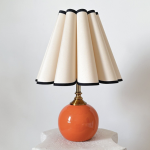
Introduction
Japanese paper lanterns are a traditional craft that has survived centuries. Their soft glow has been a part of Japanese culture for hundreds of years. Isamu Noguchi, a Japanese-American artist, was fascinated by these lanterns and began creating his own unique designs in the 1940s. Noguchi’s lanterns are among the most iconic works of his career and have become a symbol of Japanese culture around the world.
The Art of Japanese Paper Lanterns
The art of Japanese paper lanterns dates back to the Edo period in Japan, which lasted from 1603 to 1868. During this time, the shogunate ruled the country, and Japanese culture flourished. Paper lanterns were used in festivals and celebrations, and they quickly became a symbol of Japanese culture.
Traditional Japanese lanterns are made from washi, a type of paper that has been handmade in Japan for centuries. Washi is made from the bark of the mulberry tree, and it is known for its soft, delicate texture. The paper is stretched and then dried on a frame, which gives it a unique texture and translucency that is perfect for lanterns.
Isamu Noguchi
Isamu Noguchi was born in Los Angeles in 1904 to a Japanese father and an American mother. He grew up in both countries and was deeply influenced by his dual cultures. He studied sculpture in New York and Paris and established himself as one of the most important artists of the 20th century.
Noguchi was fascinated by Japanese culture and began experimenting with paper lanterns in the 1940s. His designs were an innovative blend of traditional Japanese techniques and modernist aesthetics. He created his lanterns from traditional washi paper, but he added new elements like metal frames and modern, minimalist designs.
Designs and Inspiration
Noguchi’s lanterns are characterized by their simple elegance and soft glow. He was inspired by the beauty of Japanese paper lanterns, but he also wanted to create something new and unique. His lanterns were often shaped like spheres, cubes, or cylinders, and they were designed to be hung from the ceiling or placed on a table.
One of Noguchi’s most famous designs is the Akari Light Sculpture. This sculpture is made from washi paper stretched over a metal frame, and it is designed to be hung from the ceiling. The soft light that radiates from the sculpture creates a warm, welcoming atmosphere that is perfect for any space.
Noguchi’s lanterns were also inspired by nature. He often used organic shapes and textures in his designs, including leaves, flowers, and feathers. His lanterns were not just functional objects; they were works of art that brought beauty and light into people’s homes.
Legacy
Isamu Noguchi’s Japanese paper lanterns have become an iconic symbol of Japanese culture. His designs are celebrated around the world, and his legacy continues to inspire new generations of artists and designers.
Noguchi’s lanterns were not just beautiful objects; they were also a way for him to explore his own cultural identity. He saw himself as both Japanese and American, and he used his art to bridge the cultures and create something new and innovative.
Today, Noguchi’s lanterns are highly collectible and are considered some of the most important works of his career. They continue to inspire artists and designers around the world and serve as a testament to the power of art to transcend cultural boundaries.







